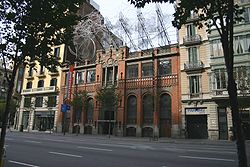
Fundació Antoni Tàpies
Encyclopedia

Barcelona
Barcelona is the second largest city in Spain after Madrid, and the capital of Catalonia, with a population of 1,621,537 within its administrative limits on a land area of...
, Catalonia
Catalonia
Catalonia is an autonomous community in northeastern Spain, with the official status of a "nationality" of Spain. Catalonia comprises four provinces: Barcelona, Girona, Lleida, and Tarragona. Its capital and largest city is Barcelona. Catalonia covers an area of 32,114 km² and has an...
(Spain), dedicated mainly to the life and works of the painter Antoni Tàpies
Antoni Tàpies
Antoni Tàpies i Puig, 1st Marquess of Tàpies is a Catalan painter. He is one of the most famous European artists of his generation. After studying law for 3 years, he devoted himself from 1943 onwards only to his painting...
.
The Fundació was created in 1984 by the artist Antoni Tàpies to promote the study and knowledge of modern and contemporary art. It combines the organisation of temporary exhibitions, symposia, lectures and film seasons with a range of publications to go with the activities and periodic shows of Antoni Tàpies’ work. The Fundació owns one of the most complete collections of Tàpies’ work, mostly made up of donations by Antoni and Teresa Tàpies.
The Fundació opened its doors in June 1990 in the building of the former Montaner i Simon publishing house, a work of the architect Lluís Domènech i Montaner
Lluís Domènech i Montaner
Lluís Domènech i Montaner was a Spanish Catalan architect who was highly influential on Modernisme català, the Catalan Art Nouveau / Jugendstil movement. He was also a Catalan politician....
, restored and refurbished by the architects Roser Amadó and Lluís Domènech Girbau. Constructed between 1880 and 1885, at an early stage of the evolution of Catalan Modernisme
Modernisme
Modernisme was a cultural movement associated with the search for Catalan national identity. It is often understood as an equivalent to a number of fin-de-siècle art movements, such as Art Nouveau, Jugendstil, Secessionism, and Liberty style, and was active from roughly 1888 to 1911 Modernisme ...
style, the building was the first in the Eixample
Eixample
The Eixample is a district of Barcelona between the old city and what were once surrounding small towns , constructed in the 19th and early 20th centuries....
district to integrate industrial typology, combining exposed brick and iron.
Transport
- Barcelona MetroBarcelona MetroThe Barcelona Metro , part of the public transportation system of Barcelona, Catalonia, is an extensive network of electrified railways that run underground in central Barcelona and above ground into the city's suburbs. Since July 31, 2010, Barcelona Metro system consists of 11 lines with 165...
station Passeig de GràciaPasseig de Gràcia (Barcelona Metro)Passeig de Gràcia is an underground railway and metro station in Barcelona located under Passeig de Gràcia, in Eixample district. It is one of the Barcelona's busiest railway stations and important stop for Barcelona Metro network...
(L2Barcelona Metro line 2Line 2 is a metro line in Barcelona operated by TMB, coloured purple and sometimes simply called línia lila. It's part of the city's ATM fare-integrated transport network...
, L3Barcelona Metro line 3— Line 3, currently known as Zona Universitària - Trinitat Nova, coloured green and often simply referred to as Línia verda , is a metro line in Barcelona operated by TMB, and therefore part of the fare-integrated ATM transport network of the urban region...
, L4Barcelona Metro line 4— Line 4, currently known as Trinitat Nova – La Pau, usually called "línia groga" , is a line in the Barcelona Metro network operated by TMB, and part of the ATM fare-integrated transport network...
)

